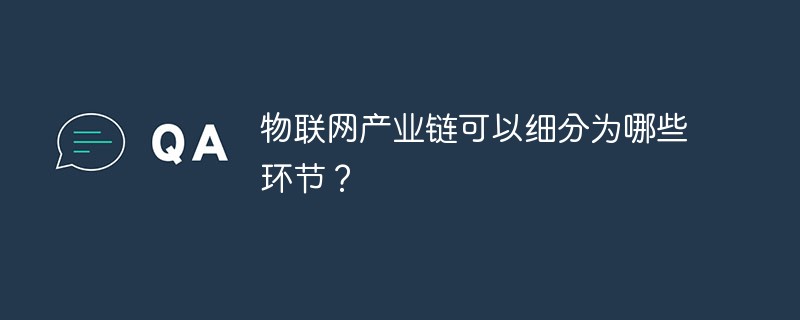
The Internet of Things industry chain can be subdivided into 4 links: "identification", "sensing", "processing" and "information transmission"; therefore, the key technologies involved in each link of the Internet of Things include: Radio Frequency Identification technology, sensor technology, sensor network technology, network communication technology, etc.

#As an "important productive force" that promotes the rapid development of the world, the Internet of Things has created another trillion-level market. Based on the rapid development of the Internet of Things, the entire industry is on the eve of an explosion. Next, we analyze the four links and four key technologies of the Internet of Things industry chain.
The Internet of Things industry chain can be subdivided into four links: identification, sensing, processing and information transmission. Therefore, the key technologies involved in each link of the Internet of Things include: radio frequency identification technology, sensor technology, sensors Network technology, network communication technology, etc.
1. Radio frequency identification (RFID) technology (Recommended learning: web front-end video tutorial)
RFID is information in the Internet of Things The main source of collection is very important in the entire Internet of Things system. RFID is a non-contact automatic identification technology with long reading distance (up to tens of meters), fast reading speed, strong penetrating ability (information can be read directly through the packaging box), no wear and tear, and non-toxic. It has the characteristics of contact, anti-pollution, high efficiency (can process multiple tags at the same time), large data storage capacity, etc. It is the only automatic identification technology that can realize multi-target recognition and can work in various harsh environments.
A typical RFID system generally consists of RFID electronic tags, readers and writers, and information processing systems. When an item with an electronic tag passes through a specific information reader, the tag is activated by the reader and transmits the information carried in the tag to the reader and information processing system through radio waves to complete the automatic collection of information. The information processing system undertakes corresponding information control and processing work according to needs. Now RFID has been officially applied in agricultural and livestock product safety production monitoring, animal identification and tracking, agricultural and livestock precision production systems, livestock product precision breeding digital systems, agricultural product logistics and packaging, etc.
2. Sensor technology
Sensors are responsible for the collection of Internet of Things information. They are the "sensory organs" for objects to perceive the physical world and are the basis for realizing the perception of the real world. It is the foundation of IoT services and applications. Sensors are usually composed of sensitive components and conversion components. They can be sensed through signals such as sound, light, electricity, heat, force, displacement, humidity, etc., and collect, analyze, and feedback the most original information for the work of the Internet of Things.
There are many types and varieties of sensors and various principles. With the development of technology, new sensor types are constantly being produced, and their application fields are becoming more and more extensive. The development and breakthroughs of sensor technology are mainly reflected in two aspects: first, the aspect of sensing information; second, the intelligence and networking of the sensor itself. In recent years, with the development of biological science, information science and material science, sensor technology has developed rapidly. Due to the rapid development of microelectronics technology and micromachining technology, sensors have a tendency to develop in the direction of miniaturization, multi-function, intelligence and networking.
3, Sensor network technology
Sensor network combines sensor technology, embedded computing technology, modern network and wireless communication technology, distributed information processing technology, etc., and can Through various integrated micro-sensors, various types of integrated micro-sensors are used to collaboratively monitor, sense and collect information on various environments or monitored objects in real time.
The information is processed through the embedded system, and the perceived information is transmitted to the user terminal through a random self-organized wireless communication network in a multihop relay manner, thereby truly realizing "ubiquitous computing" "idea. A typical sensor network structure usually consists of sensor nodes, receivers and transmitters, Internet or communication satellites, task management nodes, etc.
4. Network communication technology
No matter how the concept of the Internet of Things expands and extends, its most basic perception and communication between things is an irreplaceable key technology. Sensor network communication technology provides a transmission channel for IoT data, and how to enhance the existing network to adapt to IoT business needs (low data rate, low mobility, etc.) is the focus of current IoT research.
Sensor network communication technology is divided into two categories: short-range communication and wide-area network communication technology. Sensor network related communication technologies, common ones include Bluetooth, IrDA, Wi-Fi, ZigBee, RFID, UWB, NFC, WirelessHart, etc.
The above is the detailed content of What links can the IoT industry chain be broken down into?. For more information, please follow other related articles on the PHP Chinese website!